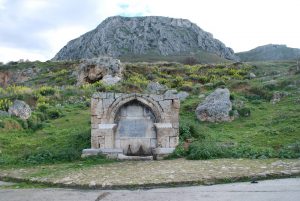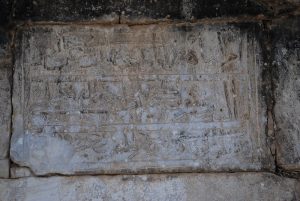THE HACI MUSTAFA FOUNTAIN
“Plan de Corinthe”, Jean-Pierre-Eugène-Félicien Peytier (from the Depot de la Guerre, 4.10 C 65.1.0057) in The French Expedition to the Morea (Work of the French Scientific Expedition to the Morea 1829-1), Melissa Publishing House, Athens 2012.
The Haci Mustafa fountain as surveyed in Peytier’s map (1829).
| Ancient Corinth | Anaploga fountain |
The Haci Mustafa fountain stands at the edge of the northern Acrocorinth slopes, below the Sanctuary of Demeter and Kore, at an elevation ca. 120 meters above sea level, close at the old path leading up to the hill. The general form of the masonry structure shows the characteristic features, which are applied to a common type of Turkish çeşme, an architectural type often met in the area of Peloponnese.
Its collective tank, built against the hill, is covered by a lowered barrel vault, which is though hardly evident by the side facades. A small opening is found at the western flank.
The four-sided fountain presents a 4,75 meter long impressive façade of limestone, built with large porous stones of equal dimensions, and spolia (marble architectural elements in secondary use) have been incorporated in the structure. A low pointed arched contour, which consists of two successive rows of voussoirs, crowns the façade (part of it has been damaged at the top), reaching a height of 3,85 meter. The protruding wings of limestone on which the arch rests, repose on two marble consoles (window pillars) set at both sides, from the early Christian period, which are decorated with a Christogram inscribed in circles in their inner side. The base of the fountain is formed by reused marble mullions, where most possibly people collecting water could sit.
Water is channeled into a large basin (kurna) of marble spoils placed under the fountain’s base. A central spout was set over the basin, while two holes have been opened sideways, one functioning till today. A long block of well-cut fish scale pattern stone was placed at the entire width of the recess above the basin that is surmounted by the donor’s inscription. The 0,95×0,60 m slab, set in the tympanum of the 0,84 meter deep recess, gives the name of the fountain’s benefactor and the date of its construction. According to the transcription of the Arabic text, the fountain owns its presence to Joseph the Tailor, who had ordered its construction in 1515 A.D. The Turkish traveler Evliya Çelebi visited the city of Ancient Corinth in A.D. in 1669 and had recorded the fountain with its inscription.
” Joseph the tailor ordered the construction of this [fountain] for flowing water entirely at his own expense, for the love of God, let Him be exalted, and desiring to please the Merciful Lord, in the nine hundred and twenty-first year [of the Hegira (1515 A.D.)].”
The fountain has taken the name of Haci Mustafa neighborhood, to which is belongs and is therefore known today under the same homonymous name.
SOURCES
Chrysafi-Zografou Metaxoula, “Τουρκικά κτίσματα στην Κόρινθο. Κρήνες και θρησκευτικά κτήρια”, ΥΠ.ΠΕ. Τεχνική Περιοδική ΈκδοσηΑναστήλωση-Συντήρηση-Προστασία Μνημείων και Συνόλων, τ. Α΄, Athens 1984, p. 261-278.
Εβλιά Τσελεμπί, Οδοιπορικό στην Ελλάδα (1668-1671), Πελοπόννησος-Νησιά Ιονίου-Κρήτη-Νησιά Αιγαίου, Loupis Dimitris (μεταφρ., σημειώσεις), εκδ. Εκάτη, Athens, p. 32-33.
Koumousi-Vgenopoulou Anastasia, “Μεσαιωνική βρύση στην Αρχαία Κόρινθο”, Αντίφωνο, Athens 1994, p.p. 196-202, 730-733.
Koumousi Anastasia, “Haci Mustafa Fountain”, in Ottoman Architecture in Greece, Brouskari Er. (ed.), Athens 2008, p. 138.
Landon Mark E., “Beyond Peirene: Toward a Broader View of Corinthian Water Supply”, in Corinth, The Centenary: 1896-1996, v. 20 (2003), published by The American School of Classical Studies at Athens, pp. 43-62.
MacKay Pierre, “The Fountain at Hadji Mustapha, in Hesperia XXXVI, vol. 36, issue 2, 1967, pp. 193-195.
Robinson Betsey A., “Histories of Peirene: A Corinthian Fountain in Three Millennia”, in Ancient Art and Architecture in Context 2.
Eleni I. Kanetaki

Haci Mustafa Fountain in ancient Corinth. Photo: E. Kanetaki.

The Ottoman inscription on the fountain. Photo: E. Kanetaki

Byzantine capital incorporated in the building material of the fountain.
Fortifications of the Ottoman periodHaci Mustafa fountain
Collection: Corinth
Type: Drawing
Name: 001 015
Title: Topographic Map of Ancient Corinth
Artist: N/A
Drawing Information: Depicts the following, Map, Topography
Date: 1964
Dimensions: 101×74
Drawing Scale: 1:2000
Storage: Hill House drawer 01
Area: Ancient Corinth
Site: AncientCorinth
City: Corinth
Country: Greecehttp://ascsa.net/id/corinth/drawing/001%20015?q=classification%3A %22%7C%20Corinthia%20%7C%20Ancient%20Corinth%22%20map&t=&v=list&p=1&sort=&s=17
Topographic map of Ancient Corinth
Collection: Corinth
Type: Drawing
Name: 001 055
Title: Property Plan of Ancient Corinth: Property owned by ASCSA
Artist: Menidiatis
Drawing Information: Depicts the following, Property, Site
Date: 1958
Notes: Notes by Travlos
Dimensions: 66×51
Drawing Scale: 1:500
Storage: Hill House drawer 01
Area: Ancient Corinth
Site: AncientCorinth
City: Corinth
Country: Greece
http://ascsa.net/id/corinth/drawing/001%20055?q=id%3A%22Corinth %3ADrawing%3A001%20055%22&t=drawing&v=table&sort=&s=1
Property Plan of Ancient Corinth: Property owned by ASCSA
WATER SOURCES IN ANCIENT CORINTH
The topographical Survey of Corinth, as prepared by WILLIAM B. DINSMOOR (1964), showed the location of Water sources, that were marked in his topographical chart of Corinth (P1. XVIII).
Plate XVIII depicts the following water sources, some of which are modern fountains of the Ottoman times: 1. Peirene 2. Sacred Spring 3. Glauke 4. Paloukovrysi 5. Tsibouri 6. Kachrou 7. Tekke 8. Mourat Aga 9. Kakavi 10. Hadji Mustafa 13. Lerna (Kriebardi) 15. Baths of Aphrodite.
The topographical Survey of Corinth, WILLIAM B. DINSMOOR, Jr. (Corinth, Results of Excavations volume I, part VI, The Springs, Peirene, Sacred spring, Glauke, by Bert Hodge Hill), 1964.
